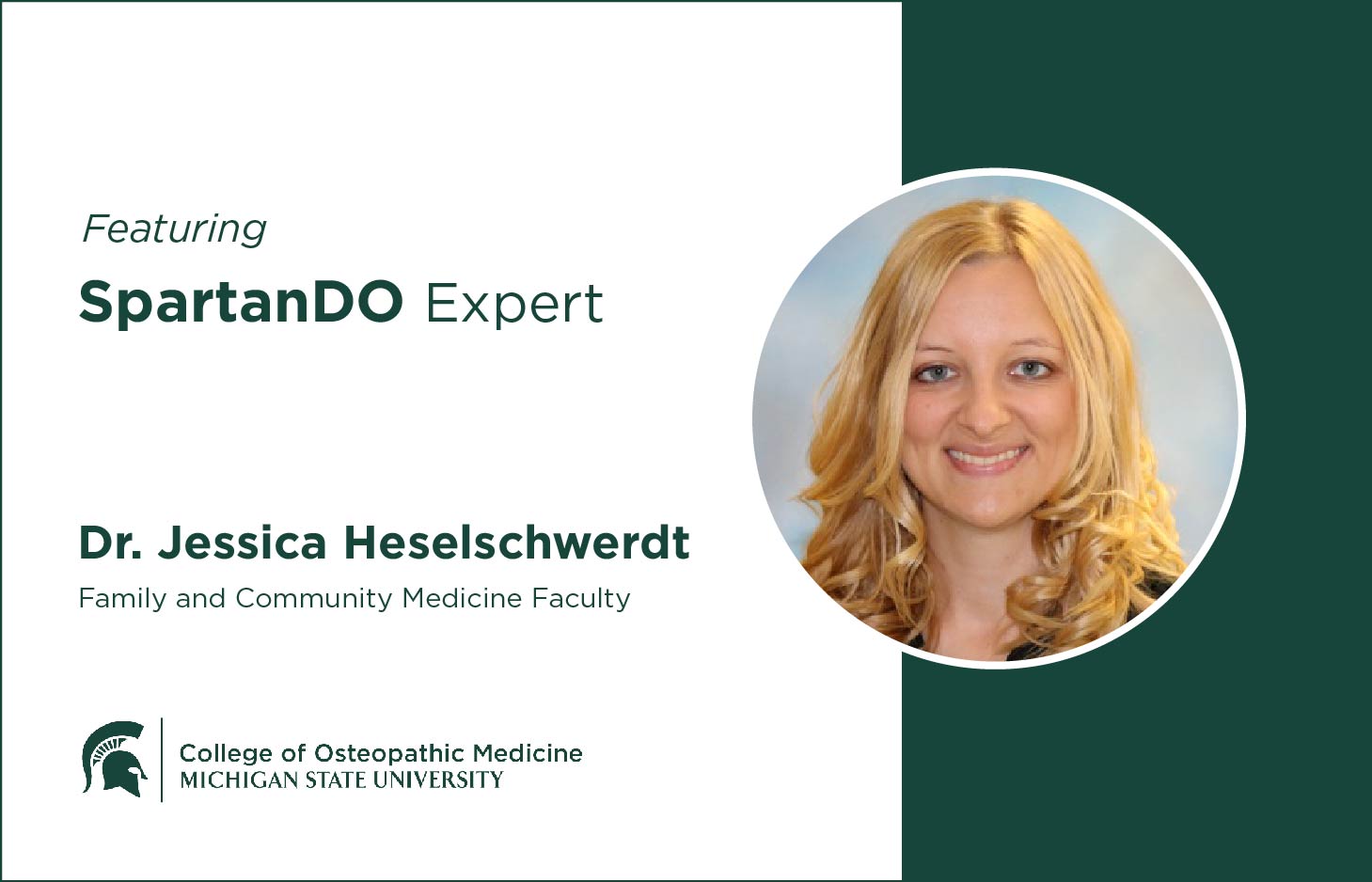SpartanDO Expert Take 2021-06
June 2021
Gender-affirming hormone therapy and inclusive healthcare environments for LGBTQ+ patients
June is Pride Month! This Expert Take blog post focuses on gender-affirming hormone therapy and how doctors can create inclusive treatment environments for LGBTQ+ patients.

“There’s a huge need for hormone treatment and not enough doctors doing it”: Gender-affirming hormone treatment as part of a comprehensive primary care practice
As part of the MSU Health Care Family Medicine team, Jessica Heselschwerdt, M.D., provides primary care for students, faculty and staff at MSU, as well as nearby community members.
An ally and advocate for LGBTQ+ patients, Heselschwerdt strongly encourages practicing clinicians and future physicians to better understand the identities, health issues and appropriate treatment and care for patients who identify as LGBTQ+. “Most doctors will have transgender patients at some point whether they know it or not, so it’s important to be good allies,” she says.
“Providing gender-affirming treatment for transgender and nonbinary patients is part of my practice,” Heselschwerdt says. “Hormone treatment is not something we learn a lot about at most med schools or residency programs, but it is part of a comprehensive primary care practice. Some patients get hormones from an endocrinologist, but they shouldn’t have to do that. It’s something that primary care doctors can and should be doing.”
Hormone therapy allows a transgender person to change their physical appearance to align with their gender identity. “Not everyone who is transgender takes hormones, but for a lot of people it’s medically necessary to relieve their dysphoria,” she explains. Once beginning hormone treatment, most patients will continue to stay on the hormones for the rest of their lives to maintain the changes.
Dr. Heselschwerdt has been providing this treatment since completing her residency, when a patient approached her for hormones. In order to go on the health journey with her patient, she took the initiative to educate herself on the topic. “The knowledge plays off what we learn in other aspects in family medicine—we know a lot about hormones to treat menopause, for example. There’s a huge need for hormone treatment and not enough doctors doing it.”
There are other gender-affirming treatments and procedures, and the current standard of care is to allow each transgender person to seek the interventions they desire (if any) to affirm their own gender identity.
Creating an inclusive medical practice
Beyond adding gender-affirming hormone therapy to a medical practice, there are many ways doctors and their teams can create a more inclusive healthcare environment for the LGBTQ+ community.
“There are a lot of barriers to accessing appropriate health care for transgender and nonbinary individuals,” Heselschwerdt says. Some of these include stigma, discrimination, and other social, economic and structural barriers. “One-third have said they’ve had negative experiences with their health care. Many have had to teach their doctor about how to treat a transgender person. It shouldn’t be that way,” she says.
Better care for LGBTQ+ patients starts with creating an inclusive and welcoming environment at intake and extends through the interaction with a patient. Dr. Heselschwerdt offers many practical tips for physicians and their teams to better serve LGBTQ+ patients:
- Educate yourself on updated terminology.
- Address the patient respectfully with the correct pronoun and their chosen name—don’t mispronoun or deadname them (referring to the person’s birth name or other previous name that may no longer align with their chosen gender). If you accidentally address the patient incorrectly, apologize briefly but sincerely.
- Design inclusive intake forms and electronic records systems, including nonbinary gender options, a preferred name in addition to their legal name and preferred pronouns.
- Use gender neutral terms, such as “patient Smith instead of Ms. Smith” if you’re not sure of the patient’s gender identity yet.
- Provide gender neutral bathrooms if possible.
- Ask questions you need to know, not out of curiosity. The questions should be relevant to why you’re seeing the patient.
- Don’t make assumptions on sexual orientation based on gender identity or perceived gender identity.
- Lastly, be a good advocate for your patients. Correct anyone who uses the wrong name or pronoun. Call or write your legislators about bills that affect the LGBTQ+ community, such as whether certain persons can use particular bathrooms, play sports on certain teams or even receive treatment. “It’s all important,” Heselschwerdt says.
Resources
For any physician or medical student interested in learning more about administering gender-affirming hormone treatment, Dr. Heselschwerdt recommends online resources such as from UCSF and Fenway Health’s National LGBTQ Health Education Center, speaking with mentors or colleagues who are familiar with hormone therapy work, and joining practice groups that allow physicians to discuss questions or challenging cases.
Dr. Heselschwerdt is also a resource, and is willing to speak with anyone with questions. Email Dr. Heselschwerdt at heselsc2@msu.edu.
Find health services by city and state.
See how physicians and researchers can contribute to increasing protective factors for LGBTQ+ youth, who are more likely to experience poor health than heterosexual or cisgender peers.
Learn more about the top health and mental health issues for LGBTQ+ communities.
Learn more about how to celebrate Pride Month and find resources for LGBTQ+ and allies.
